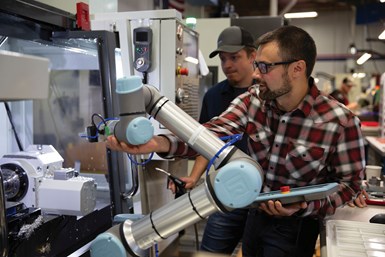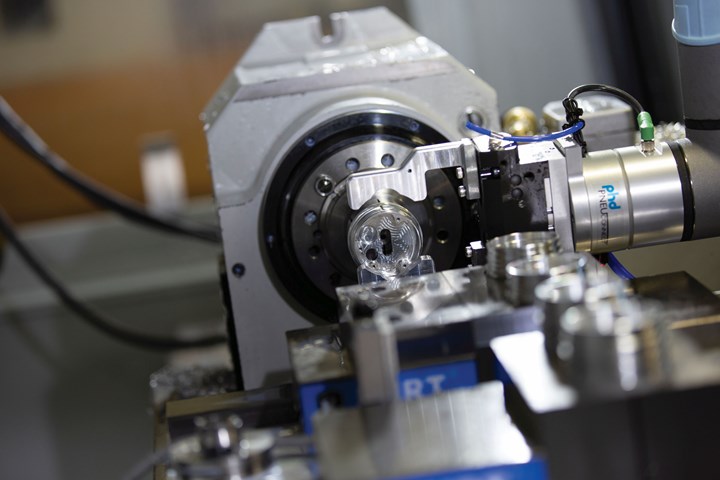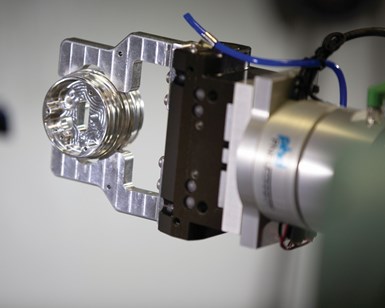
Universal Robots’ (UR) cobots can be programmed through the teach method by simply moving the arm through desired waypoints that are added to the program on the teach pendant. When the cobot was in use, Toolcraft used the UR simulator to create the entire program for the parts rinsing and drying station offline, inserting the waypoints as they transferred the program to the teach pendant. (Photo credits: Universal Robots)
When a large order necessitated adding a third shift, Monroe, Washington-based machine shop Toolcraft was having trouble hiring anyone to cover it. However, by investing in a cobot, the small shop achieved 24/7 production as well as time savings and increased throughput.
“Nobody wants to run on third shift around here,” says Steve Wittenberg, Toolcraft’s director of operations. In an area with 3% unemployment, the shop was not getting much response to its “help wanted” ad. So he started looking at different automation options, initially considering traditional industrial robots.
Looking solely at hardware, Wittenberg initially believed traditional robots would be the more cost-effective solution.. But once the shop started factoring in the savings on not having to erect a safety cage and the time saved on the ease of use, avoiding a lot of complex programming, a cobot from Universal Robots ended up being the right solution, he says.
Cobot Works the Night Shift
The order spurring this investment was for a multithreaded part for a medical device. This part needed to be loaded into a three-step CNC machining operation that would run during a third shift. Toolcraft discussed the challenge with Rapid Design Solutions, a certified systems integrator of Universal Robots.

Featuring 30-micron repeatability, the UR5e cobot was able to precisely insert the multithreaded part into the fixturing. The CNC cycle includes three operations in a vertical machining center: two in vise fixtures and one in a fourth-axis rotary unit.
“When you’re doing multioperation precision machining, the accuracy requirements go way up,” says Rapid Designs Solutions owner Troy Ojalehto. “When we heard that the repeatability of the UR5e cobot was down to 30 microns, we were very excited. That really competes in the same space as traditional industrial robots, so that was huge for us. I have not seen other cobots handling this level of precision with multioperation parts like this, with raw stock going in and completed precision parts coming out.”
Six months after implementation, Wittenberg says that Toolcraft saw a production increase right away. He notes the shop was able to “staff” a third shift with the cobot and went from producing 255 parts a week to 370 parts per week. Along with that, it was able to finish the year’s production seven weeks early, thus freeing up that machine to produce parts for other jobs.

Toolcraft chose the PneuConnect gripper from PHD as end-of-arm-tooling for the UR5e. Being UR+ certified means the gripper is certified to work seamlessly with UR cobots, with all programming software integrated directly on the UR cobot’s teach pendant.
Cobot Cleans Up
While the cobot successfully helped the shop implement 24/7 production, it still was working to its full potential. The machining cycle lasts a total of 56 minutes, but the UR5e is only busy tending parts for six minutes. “The rest of the time, the cobot was just hanging out waiting for the next cycle, “ Wittenberg explains. “We wanted to keep it busy.” Therefore, to occupy more of the cobot’s time, the shop added a parts rinsing and cleaning station.
As the UR5e takes the machined part out of the machine, it dips the part into a rinsing solution, passes it through an air jet, and places the washed and dried part on a rack for shipping. Toolcraft was also able to control the pneumatic fixture and door actuators through the UR5e I/O interfaces. “This greatly reduces the need for CNC wiring and preserves all the control’s standard safety functions,” Ojalehto explains.
Learning to Program
While Toolcraft enlisted the assistance of a system integrator to get the initial application up and running, the shop was able to program and install the rinsing and drying station on its own. “What really enabled us to do this was all the free online support Universal Robots gives you,” Wittenberg says. “After our automation engineer took the online UR Academy course, he spent a few hours with the integrator and was able to add that station to the cobot cycle.”
At first, Wittenberg feared that production would go down during the rinsing station’s programming phase since the cobot would be pulled away from its regular machine-tending duties. The team discovered, however, that they could use Universal Robots’ simulator and program almost the entire addition to the cycle offline while the cobot kept working.
The offline program is simply loaded via USB directly into the UR5e’s teach pendant. “In the program I did in my office, I’d just set blank waypoints,” says Brian Laulainen, Toolcraft’s automation engineer. Once I was next to the cobot, I was able to quickly use the free-drive motion and move the robot into the correct positions and teach the new waypoints.”
The next task he expects to be automated on the shop floor is tending a horizontal machining center. “That’s a potential challenge, because the mill uses rotary tombstones that are swapped in and out of the milling machine, which creates some difficulties with fixturing,” Wittenberg says. “But we’re confident we can solve those issues using a Universal Robot and some innovation in fixturing.”
Related Content
Pursuit of Parts Collector Spearheads New Enterprise
While searching for a small parts accumulator for Swiss-type lathes, this machine shop CEO not only found what he was looking for but also discovered how to become a distributor for the unique product.
Read MoreAutomation in the Alps: Studer AG Unveils New Grinding Concepts
Studer AG, member company of United Grinding, held its annual press conference at its Swiss Alps location earlier this month to announce its new automatic loaders to accompany its existing grinding machines as well as other offerings and automation features.
Read MoreAutomation Breakthroughs Revolutionize Precision Machining for Complex Parts
Marubeni Citizen-Cincom delivers custom solutions to address some of the biggest challenges in precision machining from handling small parts, to robot integration and unique tooling needs.
Read MoreJob Shop Discovers and Fills a Fishing Need
The promise of a product line for improved mounting of electronic fish finders led this Missouri job shop to an automated turning process.
Read MoreRead Next
Seeing Automated Workpiece Measurement in Real Time
User-friendly inspection software for CNC machining centers was shown at IMTS 2024 monitoring measurements between and after machining while performing SPC based on recorded measurement values.
Read More5 Aspects of PMTS I Appreciate
The three-day edition of the 2025 Precision Machining Technology Show kicks off at the start of April. I’ll be there, and here are some reasons why.
Read MoreDo You Have Single Points of Failure?
Plans need to be in place before a catastrophic event occurs.
Read More














.jpg;maxWidth=300;quality=90)








